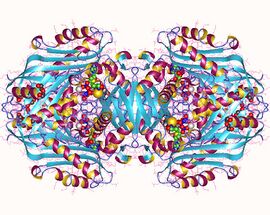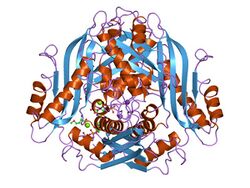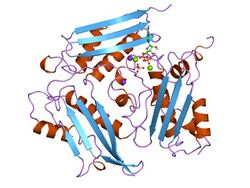Biology:S-adenosylmethionine synthetase enzyme
| Methionine adenosyltransferase | |||||||||
|---|---|---|---|---|---|---|---|---|---|
 S-adenosylmethionine synthase 2, tetramer, Human | |||||||||
| Identifiers | |||||||||
| EC number | 2.5.1.6 | ||||||||
| CAS number | 9012-52-6 | ||||||||
| Databases | |||||||||
| IntEnz | IntEnz view | ||||||||
| BRENDA | BRENDA entry | ||||||||
| ExPASy | NiceZyme view | ||||||||
| KEGG | KEGG entry | ||||||||
| MetaCyc | metabolic pathway | ||||||||
| PRIAM | profile | ||||||||
| PDB structures | RCSB PDB PDBe PDBsum | ||||||||
| |||||||||
S-adenosylmethionine synthetase (EC 2.5.1.6) (also known as methionine adenosyltransferase (MAT)) is an enzyme that creates S-adenosylmethionine (a.k.a. AdoMet, SAM or SAMe) by reacting methionine (a non-polar amino acid) and ATP (the basic currency of energy).[1]
Function
AdoMet is a methyl donor for transmethylation. It gives away its methyl group and is also the propylamino donor in polyamine biosynthesis. S-adenosylmethionine synthesis can be considered the rate-limiting step of the methionine cycle.[2]
As a methyl donor SAM allows DNA methylation. Once DNA is methylated, it switches the genes off and therefore, S-adenosylmethionine can be considered to control gene expression.[3]
SAM is also involved in gene transcription, cell proliferation, and production of secondary metabolites.[4] Hence SAM synthetase is fast becoming a drug target, in particular for the following diseases: depression, dementia, vacuolar myelopathy, liver injury, migraine, osteoarthritis, and as a potential cancer chemopreventive agent.[5]
This article discusses the protein domains that make up the SAM synthetase enzyme and how these domains contribute to its function. More specifically, this article explores the shared pseudo-3-fold symmetry that makes the domains well-adapted to their functions.[6]
This enzyme catalyses the following chemical reaction
- ATP + L-methionine + H2O [math]\displaystyle{ \rightleftharpoons }[/math] phosphate + diphosphate + S-adenosyl-L-methionine
Conserved motifs in the 3'UTR of MAT2A mRNA
A computational comparative analysis of vertebrate genome sequences have identified a cluster of 6 conserved hairpin motifs in the 3'UTR of the MAT2A messenger RNA (mRNA) transcript.[7] The predicted hairpins (named A-F) have strong evolutionary conservation and 3 of the predicted RNA structures (hairpins A, C and D) have been confirmed by in-line probing analysis. No structural changes were observed for any of the hairpins in the presence of metabolites SAM, S-adenosylhomocysteine or L-Methionine. They are proposed to be involved in transcript stability and their functionality is currently under investigation.[7]
Protein overview
The S-adenosylmethionine synthetase enzyme is found in almost every organism bar parasites which obtain AdoMet from their host. Isoenzymes are found in bacteria, budding yeast and even in mammalian mitochondria. Most MATs are homo-oligomers and the majority are tetramers. The monomers are organised into three domains formed by nonconsecutive stretches of the sequence, and the subunits interact through a large flat hydrophobic surface to form the dimers.[8]
S-adenosylmethionine synthetase N terminal domain
In molecular biology the protein domain S-adenosylmethionine synthetase N terminal domain is found at the N-terminal of the enzyme.
N terminal domain function
The N terminal domain is well conserved across different species. This may be due to its important function in substrate and cation binding. The residues involved in methionine binding are found in the N-terminal domain.[8]
N terminal domain structure
The N terminal region contains two alpha helices and four beta strands.[6]
S-adenosylmethionine synthetase Central domain
Central terminal domain function
The precise function of the central domain has not been fully elucidated, but it is thought to be important in aiding catalysis.
Central domain Structure
The central region contains two alpha helices and four beta strands.[6]
S-adenosylmethionine synthetase, C terminal domain
| S-adenosylmethionine synthetase, C-terminal domain | |||||||||
|---|---|---|---|---|---|---|---|---|---|
 Methionine adenosyltransferase in a complex ADP and l-methionine. | |||||||||
| Identifiers | |||||||||
| Symbol | S-AdoMet_synt_C | ||||||||
| Pfam | PF02773 | ||||||||
| InterPro | IPR022630 | ||||||||
| PROSITE | PDOC00369 | ||||||||
| SCOP2 | 1mxa / SCOPe / SUPFAM | ||||||||
| |||||||||
In molecular biology, the protein domain S-adenosylmethionine synthetase, C-terminal domain refers to the C terminus of the S-adenosylmethionine synthetase
C terminal domain function
The function of the C-terminal domain has been experimentally determined as being important for cytoplasmic localisation. The residues are scattered along the C-terminal domain sequence however once the protein folds, they position themselves closely together.[3]
C terminal domain Structure
The C-terminal domains contains two alpha-helices and four beta-strands.[6]
References
- ↑ "Molecular cloning and nucleotide sequence of cDNA encoding the rat kidney S-adenosylmethionine synthetase". J. Biol. Chem. 265 (23): 13683–6. August 1990. PMID 1696256.
- ↑ "Structure-function relationships in methionine adenosyltransferases.". Cell Mol Life Sci 66 (4): 636–48. 2009. doi:10.1007/s00018-008-8516-1. PMID 18953685.
- ↑ Jump up to: 3.0 3.1 "Conformational signals in the C-terminal domain of methionine adenosyltransferase I/III determine its nucleocytoplasmic distribution.". FASEB J 23 (10): 3347–60. 2009. doi:10.1096/fj.09-130187. PMID 19497982.
- ↑ "Structural and functional characterization of S-adenosylmethionine (SAM) synthetase from Pichia ciferrii.". Bioprocess Biosyst Eng 35 (1–2): 173–81. 2012. doi:10.1007/s00449-011-0640-x. PMID 21989639.
- ↑ "Structural and kinetic properties of Bacillus subtilis S-adenosylmethionine synthetase expressed in Escherichia coli.". Biochim Biophys Acta 1784 (12): 1949–58. 2008. doi:10.1016/j.bbapap.2008.06.006. PMID 18634909.
- ↑ Jump up to: 6.0 6.1 6.2 6.3 "Crystal structure of S-adenosylmethionine synthetase.". J Biol Chem 271 (1): 136–47. 1996. doi:10.1074/jbc.271.1.136. PMID 8550549.
- ↑ Jump up to: 7.0 7.1 "New families of human regulatory RNA structures identified by comparative analysis of vertebrate genomes". Genome Res. 21 (11): 1929–43. November 2011. doi:10.1101/gr.112516.110. PMID 21994249.
- ↑ Jump up to: 8.0 8.1 "Refolding and characterization of methionine adenosyltransferase from Euglena gracilis.". Protein Expr Purif 79 (1): 128–36. 2011. doi:10.1016/j.pep.2011.05.004. PMID 21605677.
External links
- Methionine+adenosyltransferase at the US National Library of Medicine Medical Subject Headings (MeSH)
- EC 2.5.1.6


